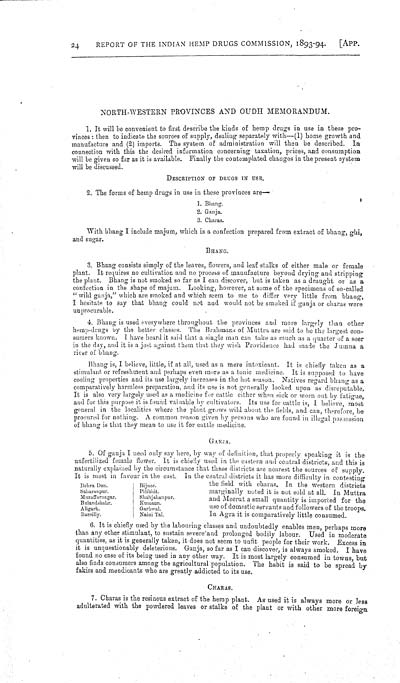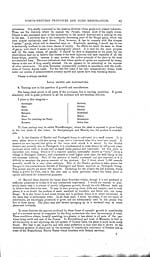Medicine - Drugs > Report of the Indian Hemp Drugs Commission, 1894-1895 > Volume III
(28) Volume 3, Page 24
Thumbnail gallery: Grid view | List view

24 REPORT OF THE INDIAN HEMP DRUGS COMMISSION, 1893-94. [APP.
NORTH-WESTERN PROVINCES AND OUDH MEMORANDUM.
1. It will be convenient
to first describe the kinds of hemp drugs in use in these
pro-
vinces: then to indicate the sources of supply, dealing separately
with—(1) home growth and
manufacture and (2) imports. The system of administration will then
be described. In
connection with this the desired information concerning taxation,
prices, and consumption
will be given so far as it is available. Finally the contemplated
changes in the present system
will be discussed.
DESCRIPTION OF DRUGS IN USE.
2. The forms of hemp drugs in use in these provinces are—
1. Bhang.
2. Ganja.
3. Charas.
With bhang I include
majum, which is a confection prepared from extract of bhang,
ghi,
and sugar.
BHANG.
3. Bhang
consists simply of the leaves, flowers, and leaf stalks of either
male or female
plant. It requires no cultivation and no process of manufacture
beyond drying and stripping
the plant. Bhang is not smoked so far as I can discover, but is
taken as a draught or as a
confection in the shape of majum. Looking, however, at some of the
specimens of so-called
"wild ganja," which are smoked and which seem to me to differ very
little from bhang,
I hesitate to say that bhang could not and would not be smoked if
ganja or charas were
unprocurable.
4. Bhang is
used everywhere throughout the provinces and more largely than
other
hemp-drugs by the better classes. The Brahmans of Muttra are said
to be the largest con-
sumers known. I have heard it said that a single man can take as
much as a quarter of a seer
in the day, and it is a jest against them that they wish Providence
had made the Jumna a
river of bhang.
Bhang is, I believe,
little, if at all, used as a mere intoxicant. It is chiefly taken
as a
stimulant or refreshment and perhaps even more as a tonic medicine.
It is supposed to have
cooling properties and its use largely increases in the hot season.
Natives regard bhang as a
comparatively harmless preparation, and its use is not generally
looked upon as disreputable.
It is also very largely used as a medicine for cattle either when
sick or worn out by fatigue,
and for this purpose it is found valuable by cultivators. Its use
for cattle is, I believe, most
general in the localities where the plant grows wild about the
fields, and can, therefore, be
procured for nothing. A common reason given by persons who are
found in illegal possession
of bhang is that they mean to use it for cattle
medicine.
|
Dehra Dun. |
Bijnor. |
|
Saharanpur. |
Pilibhit. |
|
Muzaffarnagar. |
Shahjahanpur. |
|
Bulandshahr. |
Kumaun. |
|
Aligarh. |
Garhwal. |
|
Bareilly. |
Naini Tal. |
GANJA.
5. Of ganja I
need only say here, by way of definition, that properly speaking it
is the
unfertilized female flower. It is chiefly used in the eastern and
central districts, and this is
naturally explained by the circumstance that these districts are
nearest the sources of supply.
It is most in favour in the east. In the central districts it has
more difficulty in contesting
the field with charas. In
the western districts
marginally noted it is not sold at all. In Muttra
and Meerut a small quantity is imported for the
use of domestic servants and followers of the troops.
In Agra it is comparatively little consumed.
6. It is
chiefly used by the labouring classes and undoubtedly enables men,
perhaps more
than any other stimulant, to sustain severe and prolonged bodily
labour. Used in moderate
quantities, as it is generally taken, it does not seem to unfit
people for their work. Excess in
it is unquestionably deleterious. Ganja, so far as I can discover,
is always smoked. I have
found no case of its being used in any other way. It is most
largely consumed in towns, but
also finds consumers among the agricultural population. The habit
is said to be spread by
fakirs and mendicants who are greatly addicted to its
use.
CHARAS.
7. Charas is
the resinous extract of the hemp plant. As used it is always more
or less
adulterated with the powdered leaves or stalks of the plant or with
other more foreign
Set display mode to: Large image | Zoom image | Transcription
Images and transcriptions on this page, including medium image downloads, may be used under the Creative Commons Attribution 4.0 International Licence unless otherwise stated. ![]()
| India Papers > Medicine - Drugs > Report of the Indian Hemp Drugs Commission, 1894-1895 > Volume III > (28) Volume 3, Page 24 |
|---|
| Permanent URL | https://digital.nls.uk/74551766 |
|---|---|
| Description | North-Western Provinces and Oudh memorandum |
| Description | Volume 3: Appendices. Miscellaneous. |
|---|---|
| Attribution and copyright: |
|




